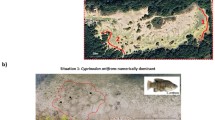Abstract
In the ocypodid crab Ilyoplax pusilla (De Haan) observed in Shirahama, Japan between 1982 and 1989, three types of territorial behavior effective in repelling neighbors are reported here in addition to barricade-building and neighbor burrow-plugging previously reported by Wada (1984, 1987). These territorial behaviors were performed by crabs larger than ca. 3.5 mm in carapace width (CW). Juvenile crabs (< ca. 3.5 mm CW) did not defend the area around their burrows, and some of them cohabited with larger crabs in the same burrows. Among crabs larger than ca. 3.5 mm CW, the territorial behavior was more diverse and prevalent in males than in females, especially larger males (> ca. 5 mm CW). Larger crabs of either sex had larger home ranges and territories. The size of the home range did not differ between males and females, but the size of territory was larger in males than in females. Thus, territorial behavior develops highly in larger males having a larger territory.
Similar content being viewed by others
Literature cited
Altevogt, R. (1955). Some studies on two species of Indian fiddler crabs, Uca marionis nitidus and U. annulipes (Latr.). J. Bombay Nat. Hist. Soc. 52:702–716
Crane, J. (1975). Fiddler crabs of the world. Princeton University Press, Princeton
Evans, S. M., Cram, A., Eaton, K., Torrance, R., Wood, V. (1976). Foraging and agonistic behaviour in the ghost crab Ocypode kuhlii de Haan. Mar. Behav. Physiol. 4:121–135
Fielder, D. R. (1970). The feeding behaviour of the sand crab Scopimera inflata (Decapoda, Ocypodidae). J. Zool. Lond. 160: 35–49
Gompper, M. E., Gittleman, J. L. (1991). Home range scaling: intraspecific and comparative trends. Oecologia 87:343–348
Griffin, D. J. G. (1968). Social and maintenance behaviour in two Australian ocypodid crabs (Crustacea: Brachyura). J. Zool., Lond. 156:291–305
Hart, D. D. (1985). Causes and consequences of territoriality in a grazing stream insect. Ecology 66:404–414
Highsmith, R. C. (1982). Induced settlement and metamorphosis of sand dollar (Dendraster excentricus) larvae in predator-free sites: adult sand dollar beds. Ecology 63:329–337
Hughes, D. A. (1966). Behavioural and ecological investigations of the crab Ocypode ceratophthalmus (Crustacea: Ocypodidae). J. Zool., Lond. 150:129–143
Hyatt, G. W. (1983). Qualitative and quantitative dimensions of crustacean aggression. In: Rebach, S., Dunham, D. W. (eds.) Studies in adaptation. The behavior of higher Crustacea. John Wiley & Sons, New York, p. 113–139
Hyatt, G. W., Salmon, M. (1978). Combat in the fiddler crabs Uca pugilator and U. pugnax: a quantitative analysis. Behaviour 65: 182–211
Jensen, G. C. (1989). Gregarious settlement by megalopae of the porcelain crabs Petrolisthes cinctipes (Randall) and P. eriomerus Stimpson. J. exp. mar. Biol. Ecol. 131:223–231
Jones, G. P. (1987). Competitive interactions among adults and juveniles in a coral reef fish. Ecology 68:1534–1547
Kosuge, T. (1989). Mating behavior of Ilyoplax pusillus (Decapoda: Ocypodidae). Nankiseibutu 31:25–30
Lindstedt, S. L., Miller, B. J., Buskirk, S. W. (1986). Home range, time, and body size in mammals. Ecology 67:413–418
Linsenmair, K. E. (1967). Konstruktion und Signalfunktion der Sandpyramide der Reiterkrabbe Ocypode saratan Forsk. (Decapoda Brachyura Ocypodidae). Z. Tierpsychol. 24:403–456
Murai, M., Goshima, S., Nakasone, Y. (1982). Some behavioral characteristics related to food supply and soil texture of burrowing habitats observed on Uca vocans vocans and U. lactea perplexa. Mar. Biol. 66:191–197
Ono, Y. (1957). The interrelation among individuals of a fiddler crab, Ilyoplax pusillus De Haan. Jap. J. Ecol. (Nippon Seitai Gakkaishi) 7:45–51
Ono, Y. (1965). On the ecological distribution of ocypoid crabs in the estuary. Mem. Fac. Sci. Kyushu Univ. (Ser E) 4:1–60
Reaka, M. L. (1987). Adult-juvenile interactions in benthic reef crustaceans. Bull. Mar. Sci. 41:108–134
Salmon, M., Hyatt, G. W. (1983). Communication. In: Vernberg, F. J., Vernberg, W. B. (eds.) The biology of Crustacea, Vol. 7. Behavior and ecology. Academic Press, New York, p. 1–40
Schoener, T. W. (1968). Sizes of feeding territories among birds. Ecology 49:123–141
Schoener, T. W., Schoener, A. (1982). Intraspecific variation in home range size in some Anolis lizards. Ecology 63:809–823
Sexton, Q. J. (1960). Some aspects of the behavior and of the territory of a dendrobatid frog, Prostherapis trinitatis. Ecology 41: 107–115
Simon, C. A. (1975). The influence of food abundance on territory size in the iguanid lizard Sceloporus jarrovi. Ecology 56:993–998
Stimson, J. (1970). Territorial behavior of the owl, limpet, Lottia gigantea. Ecology 51:113–118
Tweedie, M. W. F. (1935). Notes, on the genus Ilyoplax Stimpson (Brachyura, Ocypodidae). Bull. Raffles Mus. 10:53–61
Upton, N. P. D. (1987). Gregarious larval settlement within a restricted intertidal zone and sex differences in subsequent mortality in the polygynous saltmarsh isopod Paragnathia formica (Crustacea: Isopoda). J. mar. biol. Ass. U.K. 67:663–678
Vannini, M., Sardini, A. (1971). Aggressivity and dominance in river crab Potamon fluviatile (Herbst). Monitore zool. ital. (NS) 5:173–213
Wada, K. (1981). Growth, breeding, and recruitment in Scopimera globosa and Ilyoplax pusillus (Crustacea: Ocypodidae) in the estuary of Waka River, middle Japan. Publ. Seto mar. biol. Lab. 26:243–259
Wada, K. (1983). Spatial distributions and population structures in Scopimera globosa and Ilyoplax pusillus (Decapoda: Ocypodidae). Publ. Seto mar. biol. Lab. 27:281–291
Wada, K. (1987). Barricade building in Ilyoplax pusillus (De Haan) (Crustacea: Brachyura). J. exp. mar. Biol. Ecol. 83:73–88
Wada, K. (1987). Neighbor burrow-plugging in Ilyoplax pusillus (Crustacea: Brachyura: Ocypodidae). Mar. Biol. 95:299–303
Warner, G. F. (1970). Behaviour of two species of grapsid crab during intraspecific encounters. Behaviour 36:9–19
Warner, G. F. (1977). The biology of crabs. Elek Science. London
Woodin, S. A. (1976). Adult-larval interactions in dense infaunal assemblages: patterns of abundance. J. mar. Res. 34:25–41
Zucker, N. (1974). Shelter building as a means of reducing territory size in the fiddler crab, Uca terpsichores (Crustacea: Ocypodidae). Am Midl. Nat. 91:224–236
Author information
Authors and Affiliations
Additional information
Communicated by T. Ikeda, Niigata
Rights and permissions
About this article
Cite this article
Wada, K. Territorial behavior, and sizes of home range and territory, in relation to sex and body size in Ilyoplax pusilla (Crustacea: Brachyura: Ocypodidae). Marine Biology 115, 47–52 (1993). https://doi.org/10.1007/BF00349385
Received:
Accepted:
Issue Date:
DOI: https://doi.org/10.1007/BF00349385




